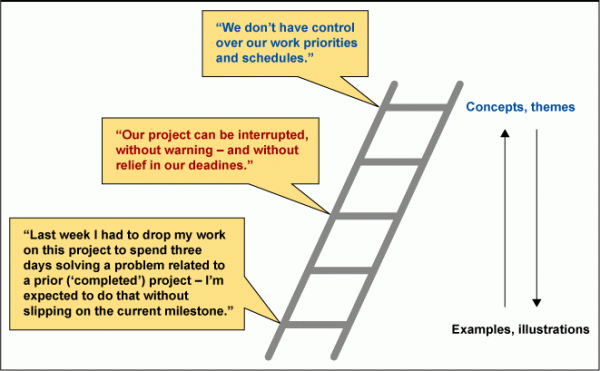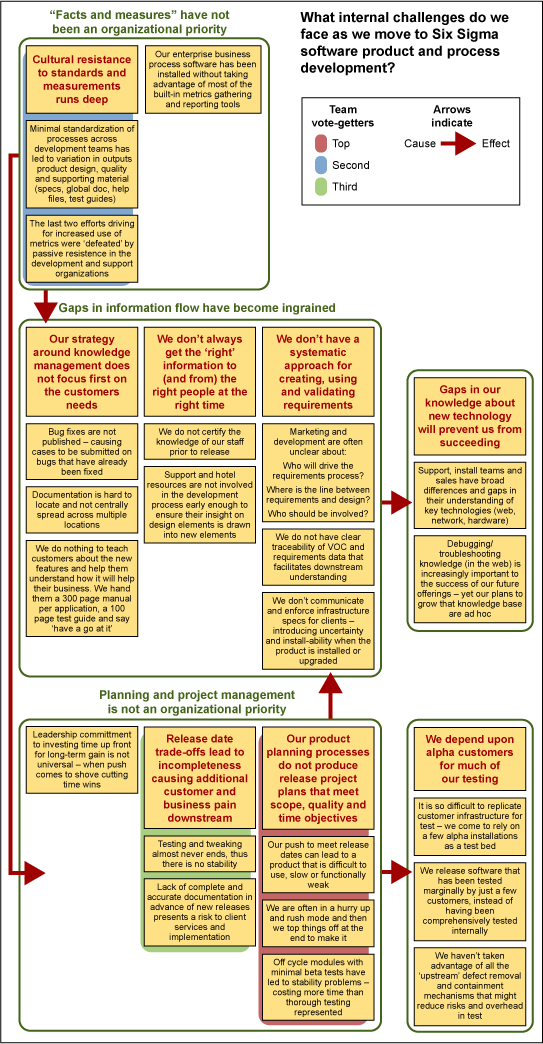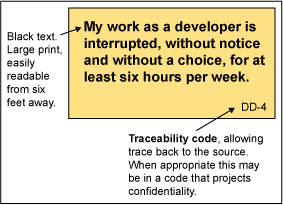
KJ Analysis is a method of developing insight into themes and relationships among issues. It helps drill from high-level issues at one level of context (usually abstract or vague) to a more detailed set of common, reusable statements. KJ is particularly useful in software because people have a tendency to state problems as abstract characteristics they do not like as opposed to making data-based statements about what they need. KJ is helpful in creating a flow-down of information leading to solid requirements at an appropriate level of context.
KJ can be used effectively in Six Sigma projects. And Six Sigma practitioners can benefit by a proper understanding of the approach.
Jiro Kawakita, whose Japanese initials “KJ” are the tag for the methodology he founded, deserves a great deal more visibility and credit for his insights and contribution to practical data-driven learning. As an anthropologist in the 1950s, he was confronted with lots of snippets of factual language data from his field research, and he had an “aha!” about using rules of abstraction to group the data and distill useful fundamental messages. His problem was not unlike today’s software developer’s in many areas of requirements development and problem formulation – where there is a sampling of data that touches on many important aspects of the story. Kawakita found a robust way to amplify the signal and reject a good amount of the noise in that data.
Contrasting KJ and Affinity Diagram
A number of web sites describe KJ as another name for an affinity diagram. This is an unfortunate generalization. Table 1 outlines some key distinctions between the two. Central is the fact that KJ focuses on facts, putting some rules around the traceability and clarity of every piece of language data introduced. This reduces variation in the meaning to be distilled – recognizing that no amount of language processing can overcome vague and ill-founded facts (garbage in/garbage out). Affinity diagrams, on the other hand, often encourage brainstorming, letting all ideas into the mix. Even before each tool kicks in, this difference in the incoming data is a major distinction.
| Table 1: Contrasting KJ and Affinity Diagram | ||
| Affinity Diagram | KJ Analysis | |
| Preparation | Little or none, spontaneous | Care taken in constructing a “theme” question |
| Source Material | Ideas, brainstorming | Facts, data gathering |
| Grouping | Quick, informal, logical grouping; often based on keywords; often no limit on group size – grouping is encouraged | Pensive, in silence, based on “the story being told” in each note; typically three maximum per group – “lone wolves” are encouraged |
| Titling of Groups | Quick, informal, “printer problems,” “poor communication” | Disciplined, using rules of abstraction; complete sentences that answer the theme questions |
| Reflection/Post Processing | Little or none, a stack of groups is often it | Cause-and-effect dynamics, voting and conclusion statement powerfully capture insight |
The nature of language processing driven by each tool is quite different as well. KJ carefully guides team thinking on what constitutes a language data group and limits the size of each group. The rationale for grouping is different in KJ – specifying abstraction as the guiding force. A KJ invites factual data like the black text at the bottom of the “ladder of abstraction” (Figure 1). Through grouping with other data that tells a related story, KJ labels move up in abstraction (as illustrated by the more general phrases in the red and blue moving up the ladder). This is a right-brain association activity. Affinity groupings often allow or encourage logical left-brain grouping.

Three Special Purpose KJs
One “hidden” power of KJ is its ability to adapt to special uses. Table 2 outlines three KJ types that have been most useful. The thing that creates a new KJ type is the “theme” statement – the question that is inviting all the data as factual answers. Small changes in the theme statement, even within one of these types, can make a big difference in the team experience building it, and in the outcome.
| Table 2: Special Purpose KJs | |||
| KJ Type | Theme | Data | Uses |
| Weakness or Problem- Formulation |
What has been preventing us from…? | Fact related to problems or obstacles (A major customer became confused with all the options and pulled out of the sales process.) | Formulating a problem; focusing on where to do more detailed problem-solving work |
| Context of Image |
What scenes and images describe…? | Word pictures (Forgetting to record information in his log, a staffer then fills it in from memory.) | Understanding an environment |
| Requirements | What are the key requirements for…? | Needs – Solution-free (Users define customer quality control procedures as required for their region.) | Finding themes and underlying messages in a complex set of needs |
Weakness or Problem-Formulation KJ – This KJ is probably the best place for a new facilitator or team to start. The theme takes on a weakness tone, looking for problems, obstacles, challenges, etc. The power in a weakness orientation is that it focuses a team on facts – and on the present and past. In contrast with the affinity diagram, this KJ does not seek ideas or brainstorming. That is an important point. It might seem more optimistic to say, “What can we do to improve X?” But that would seek ungrounded ideas. Turning the same situation around to a weakness view, it becomes, “What are our key problems with X?” That creates an entirely different set of responses. Sounds a bit pessimistic, but actually it is that way for a positive reason – to pull out the most pertinent, useful facts.

Context or Image KJ – A context KJ, also know as image KJ, seeks to document and distill powerful word pictures describing an environment. It is the KJ with the broadest reach. At first, many people have trouble distinguishing this from a problem-formulation KJ. A context KJ calls for all manner of images that describe “the way things are” in the environment of interest. Problems and weakness may show up as part of that picture – to the extent that they provide useful answers to the theme question. In addition, a context KJ may include images about future trends, and situations and dynamics that are neutral or positive. The problem-formulation KJ, with its focus on weakness, puts a narrower filter on the incoming data.
Requirements KJ – A requirements KJ calls for functionality in answer to a theme question such as, “What are the key requirements for…?” Many times the facts are in the form of a quote, representing a customer or “actor” describing what they need or would like to be able to do. “I can track and change my own orders online” or “For at least three years, we need to manage a mixture of the newest and some of the oldest technology” would be examples of basic fact statements at the base of a requirements KJ.
When to Do a KJ
To help decide whether to do language processing and, if so, whether to use affinity or KJ, consider these steps:
- Articulate the theme: the top-level question the team would like to use the data to answer.
- Develop the list of participants the team would like to see working on this.
- Gage the prospective value of the activity on these dimensions in the Language Data Processing Planner form below.
| Language Data Processing Planner | |||
| Assign a prospective value for each activity, scoring anywhere between 1 and 5 |
Score |
||
| Perspective |
1 |
5 | _________ |
| The participants already have a common view of the data they would bring | Participants have different data and different perspectives. There is value in their seeing the issue from one another’s perspective | ||
| Complexity |
1 |
5 | _________ |
| The issues (regarding the theme) are not particularly complex. The hierarchy and/or relationships among the data are pretty constrained and easy to see already. | The issue is complex. There are many ways the data could be distilled. It is not easy to see what the distilled answers would be. | ||
| Urgency |
1 |
5 | _________ |
| Most participants would not see this as an issue worth spending time on. | Most participants see the value in better understanding this issue right away. | ||
| Communication/ Documentation |
1 |
5 | _________ |
| We already have the data in a form that is communicable or reusable by others. | The data regarding this issue is dispersed. It is hard to see the forest for the trees. | ||
| Total Score |
_________ | ||
Interpreting the Planner Score:
Up to about 6 – Team KJ not worthwhile. Consider simple affinity or net-touch grouping by a smaller team, or no data processing if appropriate.
About 8 to 10 – Reconsider the theme and/or participant list.
About 12 and above – A KJ is probably worthwhile.
If a team decides to do a KJ, it should remember the data input fundamentals in the illustration below:

More on Language Processing
- The Original KJ Method by Jiro Kawakita, Kawakita Research Institute, 1991.
- The Language Processing Method by Shoji Shiba, et al, CQM, Boston, 1995.
- Language in Thought and Action by S.I. and Alan R. Hayakawa, Harcourt Brace Jovanovich, fifth edition, 1990.
- Customer Visits by Edward F. McQuarrie, Sage Press, second edition, 1995.
Scrubbing the Data – Part of the KJ discipline involves “scrubbing” the language on each of these incoming notes. Each note wants to be stated in “report language.” Also, the message in the note wants to be clear and unambiguous to any reader downstream – especially those who did not take part in the building of the KJ. Team members can help that process by putting each of their own notes to the test, rewording as necessary, before coming to a KJ meeting.
After KJ Is Done, Then What?
A good KJ session should yield several rewards. First, the team that created the KJ usually finds big gains in shared understanding about one another’s perspectives and facts. By working together to group, title and arrange their data, a team gets inside a common thought process about important meanings and dynamics.
For people who were not on the team, a KJ is a very efficient communication document. If the team had spent the same few hours in chairs around the meeting table with someone taking notes, it would be a longshot that many others would read and understand the notes. The KJ, on the other hand, is a 2-D pattern-oriented device that almost immediately conveys lots of information and related thought process to those who were not there. It is perfect for the “one-minute manager.”
Last but not least, over time a KJ can help the team that built it to remember and reflect back on their thinking. It can reboot the group mind months or even years later. KJs should be kept in an accessible place (and as online shareable versions) to get all possible benefits.